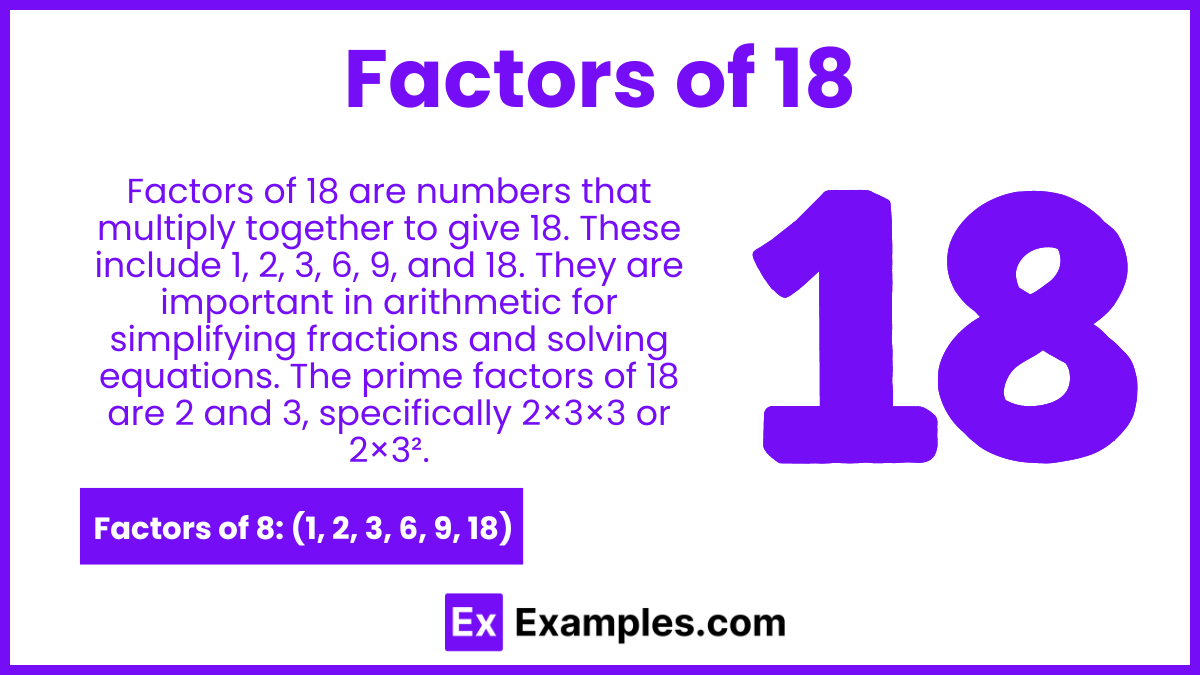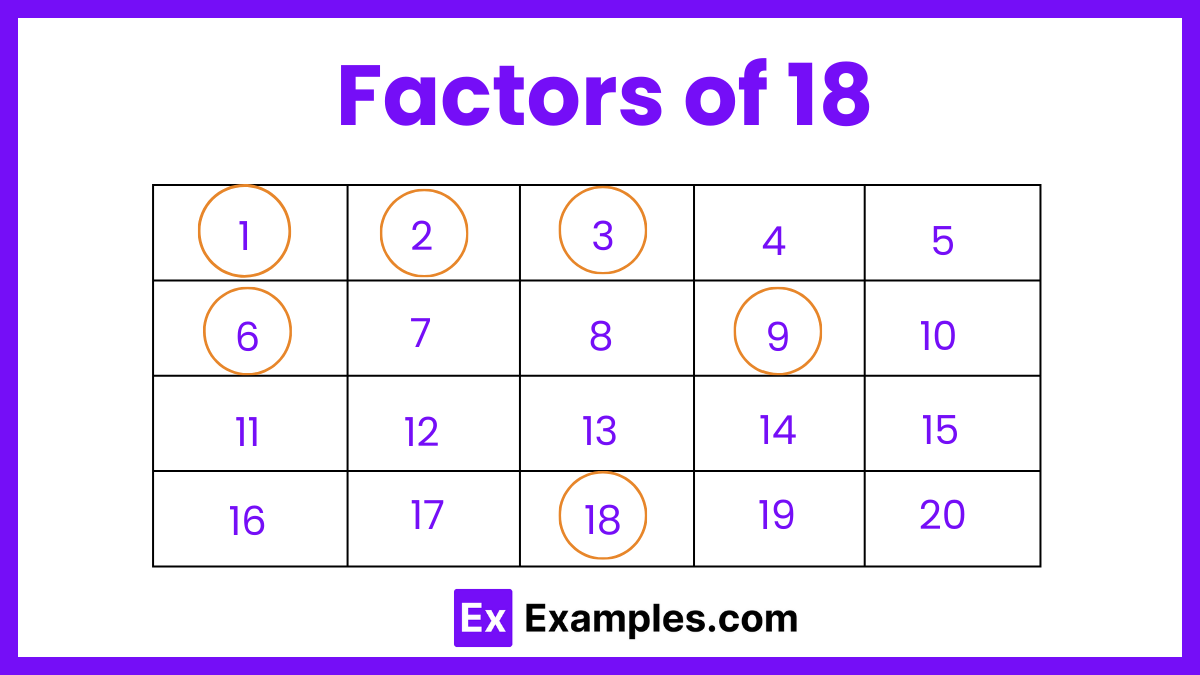Which of the following is not a factor of 18?
7
3
1
6

The factors of 18 are the numbers that divide 18 exactly without leaving a remainder. These factors are fundamental in mathematics, playing a crucial role in simplifying fractions, solving equations, and determining common multiples. Knowing the factors of a number like 18 helps in various mathematical operations and real-world applications, such as problem-solving and analytical tasks. Understanding these factors can also aid in recognizing patterns and relationships between numbers, making mathematical concepts easier to grasp and apply. This article explores the factors of 18, how to determine them, and their importance in different contexts.

The factors of 18 are the numbers that can divide 18 without leaving a remainder. These include 1, 2, 3, 6, 9, and 18. Identifying these factors is essential in simplifying mathematical problems, finding common multiples, and solving equations. Understanding the factors of 18 helps in various applications, making mathematical concepts easier to apply in real-world scenarios.
Understanding factor pairs is essential in breaking down a number into its components. Factor pairs of 18 are sets of two numbers that, when multiplied together, equal 18. These pairs are useful in various mathematical problems, including simplifying equations, finding common denominators, and solving algebraic expressions.
Calculating the factors of 18 involves finding all the numbers that divide 18 exactly without leaving a remainder. This process is straightforward and can be done by following a few simple steps. Understanding how to find factors is essential in various mathematical tasks, such as simplifying fractions, solving equations, and analyzing number patterns.
Begin by noting that 1 and the number itself (18) are always factors. So, 1 and 18 are the first factor pair.
Next, check if 18 is divisible by 2. Since 18 is an even number, it is divisible by 2. This gives the factor pair 2 and 9 (because 18 ÷ 2 = 9).
Check if 18 is divisible by 3. Since the sum of the digits of 18 (1 + 8 = 9) is divisible by 3, 18 is also divisible by 3. This results in the factor pair 3 and 6 (because 18 ÷ 3 = 6).
Continue this process up to the square root of 18 (approximately 4.24). For each number, check if it divides 18 exactly. In this case, 4 does not divide 18 evenly, so no further factor pairs are found.
To check if 2 is a factor of 18, divide 18 by 2. 18÷2=918÷2=9 Since 9 is a whole number, 2 is a factor of 18. The factor pair here is (2, 9).
To verify if 3 is a factor of 18, divide 18 by 3. 18÷3=618÷3=6 Since 6 is a whole number, 3 is a factor of 18. The factor pair here is (3, 6).
To check if 6 is a factor of 18, divide 18 by 6. 18÷6=318÷6=3 Since 3 is a whole number, 6 is a factor of 18. The factor pair here is (6, 3).
To determine if 9 is a factor of 18, divide 18 by 9. 18÷9=218÷9=2 Since 2 is a whole number, 9 is a factor of 18. The factor pair here is (9, 2).
To verify if 1 is a factor of 18, divide 18 by 1. 18÷1=1818÷1=18 Since 18 is a whole number, 1 is a factor of 18. The factor pair here is (1, 18).
Calculating the factors of 18 can be made easier with a few helpful tips. These tips can streamline the process and ensure accuracy when identifying all the factors.
The prime factors of 18 are the prime numbers that multiply together to give 18. The prime factorization of 18 is 2 x 3 x 3 or 2×32.
Yes, 18 is a composite number because it has more than two factors.
Factors of 18 are the numbers that can divide 18 without leaving a remainder, whereas multiples of 18 are the numbers that result from multiplying 18 by any integer (e.g., 18, 36, 54, etc.).
The greatest common factor of 18 and another number is the largest factor that both numbers share. For example, the GCF of 18 and 24 is 6.
The sum of the factors of 18 (1, 2, 3, 6, 9, 18) is 1 + 2 + 3 + 6 + 9 + 18 = 39.
The positive pair factors of 18 are (1, 18), (2, 9), and (3, 6). The negative pair factors are (-1, -18), (-2, -9), and (-3, -6). Both positive and negative pairs, when multiplied together, yield the product 18, showcasing how factors can include both positive and negative integers.
Text prompt
Add Tone
10 Examples of Public speaking
20 Examples of Gas lighting
Which of the following is not a factor of 18?
7
3
1
6
Which factor of 18 is a multiple of 3?
2
4
6
8
Which factor of 18 is equal to the difference between 18 and 12?
3
6
9
12
What is the sum of all factors of 18?
18
27
36
45
Which factor of 18 is an odd number?
2
6
9
18
Which factor of 18 is not included in the set of factors of 20?
1
2
6
9
What is the product of the smallest and largest factors of 18?
18
36
54
12
Which factor of 18 is closest to its square root?
2
3
6
9
If you subtract 1 from which factor of 18, you get another factor of 18?
6
9
18
12
Which factor of 18 is also a factor of 36?
4
7
9
5
Before you leave, take our quick quiz to enhance your learning!

